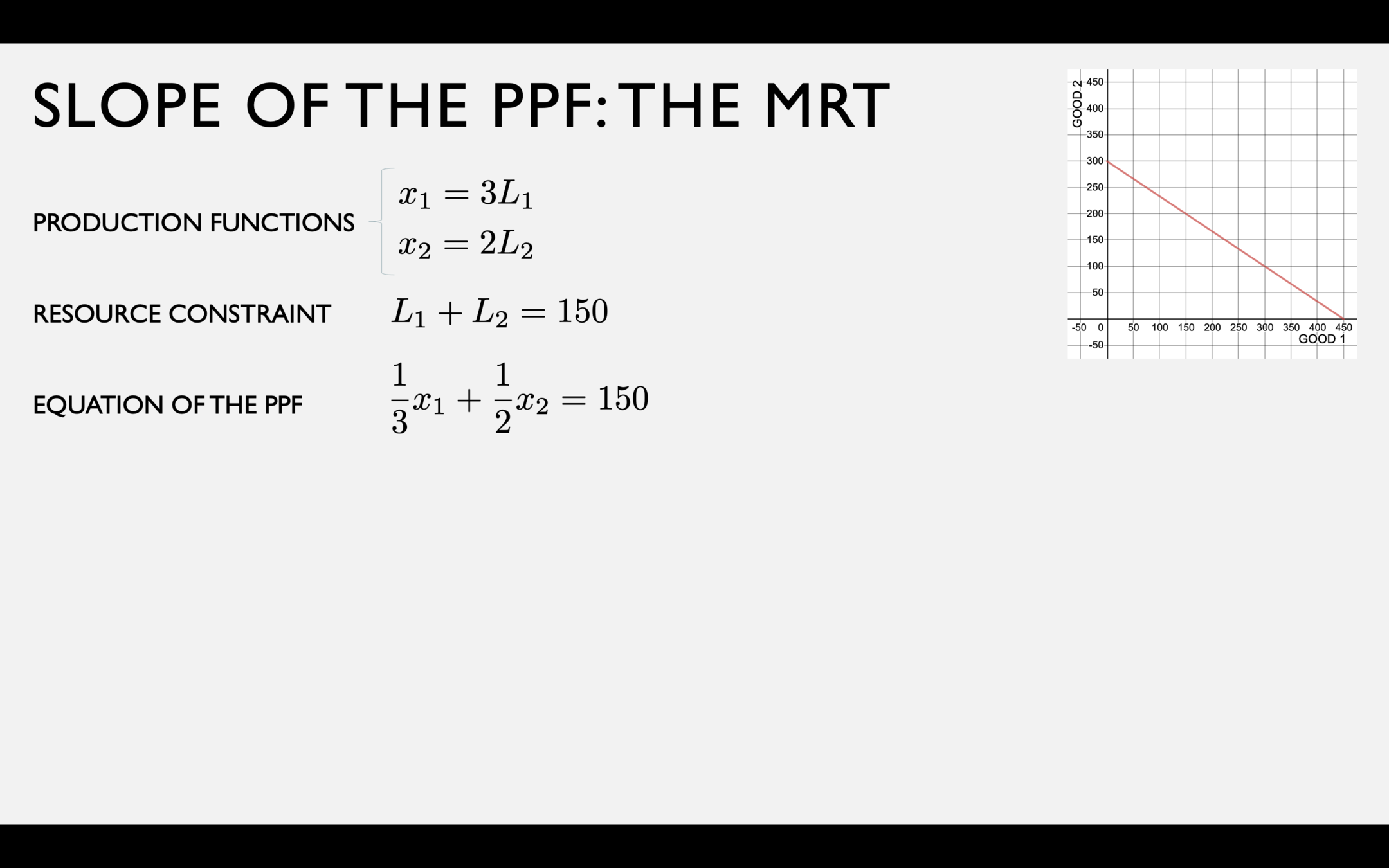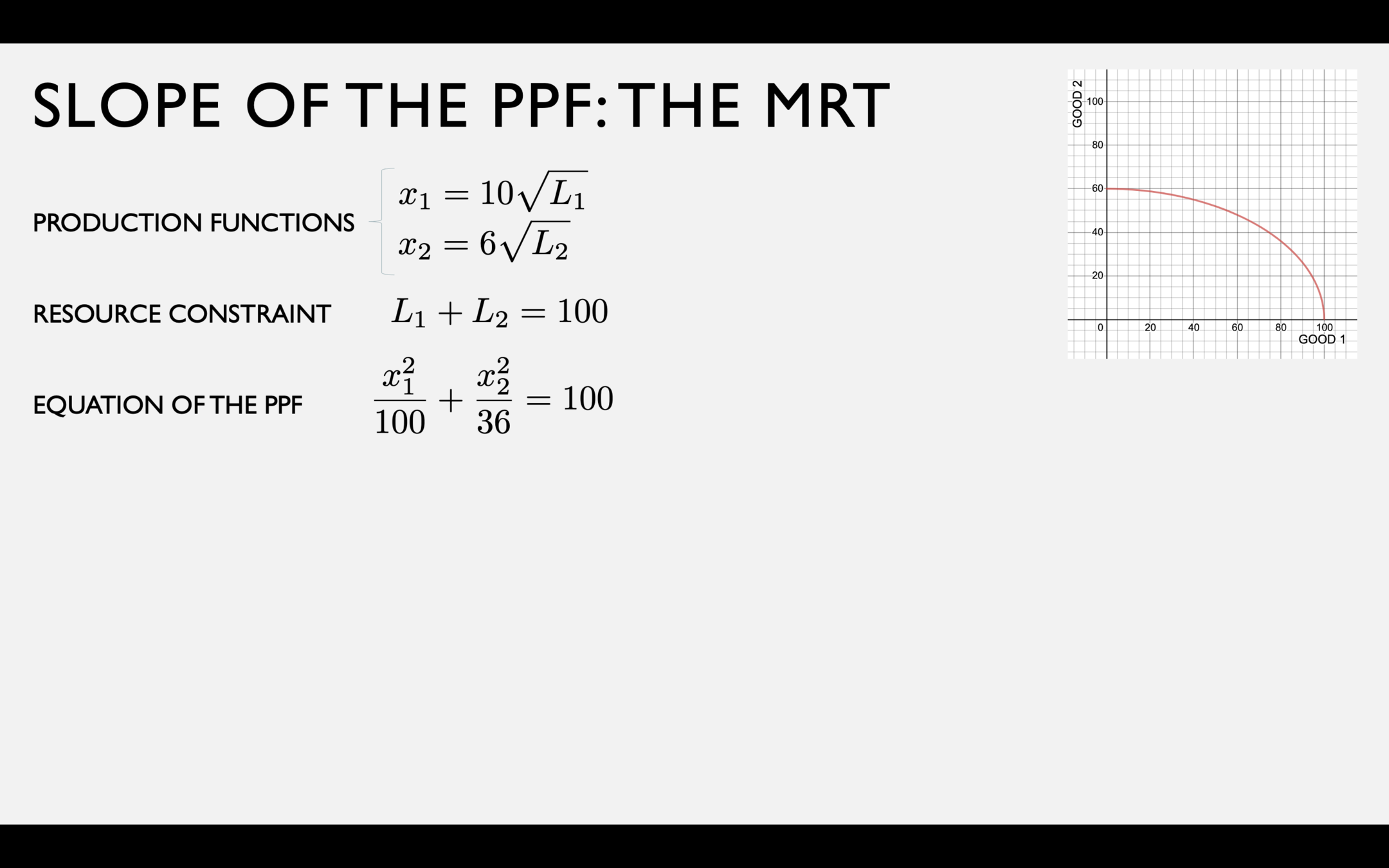pollev.com/chrismakler

Today's Attendance Question
What is the color of the shirt I'm wearing?
The Implicit Function Theorem: Mathematical Derivation and Economic Interpretations
Christopher Makler
Stanford University Department of Economics
Econ 50: Lecture 6
General Function
(lecture 3)
Isoquant
(lecture 4)
PPF
(lecture 5)
Level Set
Magnitude of the slope of the level set
MRTS
MRT
Today's agenda: establish the intuition behind these formulas.
Multivariable Chain Rule
Total Derivative Along a Path
Total Derivative Along a Path
The total change in the height of the function due to a small increase in \(x\)
The amount \(f\) changes due to the increase in \(x\)
[indirect effect through \(y\)]
The amount \(f\) changes due to an increase in \(y\)
The amount \(y\) changes due to an increase in \(x\)
[direct effect from \(x\)]
Derivative Along a Level Set
Take total derivative of both sides with respect to x:
Solve for \(dy/dx\):
IMPLICIT FUNCTION THEOREM
pollev.com/chrismakler

Consider the multivariable function
What is the slope of the level set passing through the point (1, 5)?
Consider the multivariable function
What is the slope of the level set passing through the point (1, 5)?
Slope of level set = —
Marginal Rate of Technical Substitution (MRTS)
Economic definition: the rate at which a producer can substitute one input for another while keeping output at the same level
Mathematical definition: slope of an isoquant
Recall: by implicit function theorem,
the slope of a level set is given by
Therefore the formula for the MRTS is
(absolute value)
Labor (L)
Capital (K)
Intuition behind the formula for the MRTS
Example: Cobb-Douglas Production Function
Story
If Chuck uses his bare hands (L), he can catch 2 fish per hour.
If Chuck uses a net (K),
he can collect 4 fish per net.
Model
Fish from L hours of labor = 2L
Fish from K nets = 4K
How many fish can he produce altogether if he uses
L hours of labor, and K nets?
If Chuck uses his bare hands (L), he can catch 2 fish per hour.
If Chuck uses a net (K),
he can collect 4 fish per net.
Intuition: no matter how many hours he works, and how many nets he uses,
he can catch the same number of fish with 1 net as he can using 2 hours of labor.
Linear Production Function
Linear Production Function
What happens to an isoquant if \(a\) increases?
L
K
Cobb-Douglas Production Function
Cobb-Douglas Production Function
What does the isoquant for \(q = 4\) look like?


CES Production Function
MRTS for Different Production Functions
Linear
Cobb-Douglas
CES
NOTE THAT THESE ARE FUNCTIONS OF L AND K, NOT JUST OF L!!!
DO NOT CONVERT INTO A UNIVARIATE FUNCTION AND TAKE THE DERIVATIVE!!!
Slope of the PPF:
Marginal Rate of Transformation (MRT)
Rate at which one good may be “transformed" into another
...by reallocating resources from one to the other.
Opportunity cost of producing an additional unit of good 1,
in terms of good 2
Note: as with the MRTS, we will generally treat this as a positive number
(the magnitude of the slope)

This is just a level set of the function \(L(x_1,x_2) = {1 \over 3}x_1 + {1 \over 2}x_2\)
By the implicit function theorem:

This is just a level set of the function \(L(x_1,x_2) = \)
By the implicit function theorem:
Total labor required to produce the bundle \((x_1,x_2)\)
\(L_1(x_1) + L_2(x_2)\)
\({1 \over 3}x_1 + {1 \over 2}x_2\)
Recall: \(MP_{L1} = {dx_1 \over dL_1}, MP_{L2} = {dx_2 \over dL_2}\)
Suppose we're allocating 100 units of labor to fish (good 1),
and 50 of labor to coconuts (good 2).
Now suppose we shift
one unit of labor
from coconuts to fish.
How many fish do we gain?
100
98
300
303
How many coconuts do we lose?
Relationship between MPL's and MRT
Fish production function
Coconut production function
Resource Constraint
PPF
Diminishing \(MP_L\)'s
and Increasing \(MRT\)

This is a level set of the function \(f(x_1,x_2) = {1 \over 100}x_1^2 + {1 \over 36}x_2^2\)
By the implicit function theorem:
Important Notes
The MRT is the slope of the PPF at some output combination \((x_1,x_2)\)
You should therefore write it in terms of \(x_1\) and \(x_2\), not \(L_1\) and \(L_2\).
Even though we show the relationship between the MRT and the MPL's, in general you should use the implicit function theorem to find it!
CHECK YOUR UNDERSTANDING
pollev.com/chrismakler

Charlene has the PPF given by
\(2x_1^3 + 3x_2^4 = 1072\)
What is her MRT if she produces the output combination \((8,2)\)?
Since \(x_1^2 = 64\) and \(x_2^3 = 8\), this is 4.
By the implicit function theorem:
DO NOT SOLVE FOR X2 AS A FUNCTION OF X1 AND TAKE THE DERIVATIVE!!!!
- The implicit function theorem is a general mathematical theorem giving the slope of a level set at a point.
- We applied this function today in two contexts.
- Remember what the units of the axes are!!!! That determines the variables you should use in describing the slope, as well as the units of the slope!
- DO NOT JUST CONVERT TO A UNIVARIATE FUNCTION.
THIS WILL LEAD YOU DOWN A BAD PATH AND
YOU WILL GET MANY MANY POINTS OFF ON EXAMS.
Key Takeaways
Econ 50 | Lecture 06
By Chris Makler
Econ 50 | Lecture 06
Welcome to Econ 50
- 479



